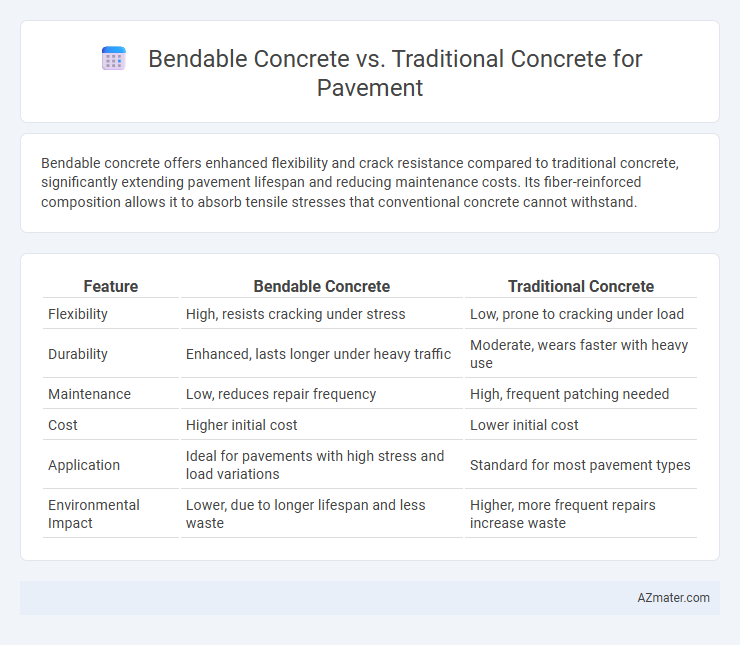Bendable concrete offers enhanced flexibility and crack resistance compared to traditional concrete, significantly extending pavement lifespan and reducing maintenance costs. Its fiber-reinforced composition allows it to absorb tensile stresses that conventional concrete cannot withstand.
Table of Comparison
| Feature | Bendable Concrete | Traditional Concrete |
|---|---|---|
| Flexibility | High, resists cracking under stress | Low, prone to cracking under load |
| Durability | Enhanced, lasts longer under heavy traffic | Moderate, wears faster with heavy use |
| Maintenance | Low, reduces repair frequency | High, frequent patching needed |
| Cost | Higher initial cost | Lower initial cost |
| Application | Ideal for pavements with high stress and load variations | Standard for most pavement types |
| Environmental Impact | Lower, due to longer lifespan and less waste | Higher, more frequent repairs increase waste |
Introduction to Bendable and Traditional Concrete
Bendable concrete, also known as fiber-reinforced concrete, incorporates polymer fibers to enhance tensile strength and flexibility, making it ideal for pavement applications requiring crack resistance and durability. Traditional concrete, composed mainly of cement, water, and aggregate, is strong in compression but susceptible to cracking under tensile stress, leading to higher maintenance costs in pavement structures. The integration of fibers in bendable concrete significantly improves performance by distributing stresses and reducing micro-cracks, extending pavement lifespan compared to conventional concrete.
Composition Differences: Bendable vs Traditional Concrete
Bendable concrete incorporates fibers, such as glass or synthetic fibers, that enhance tensile strength and flexibility, contrasting with traditional concrete composed primarily of cement, water, and aggregates like sand and gravel. This fiber reinforcement allows bendable concrete to resist cracking and distribute stress more effectively under load, while traditional concrete relies on its compressive strength but is prone to brittle failure. The modified composition of bendable concrete results in higher durability and reduced maintenance for pavement applications compared to the conventional mix.
Flexibility and Durability Comparison
Bendable concrete, featuring engineered fiber reinforcement, exhibits significantly higher flexibility than traditional concrete, allowing it to endure greater tensile stresses without cracking. Its enhanced durability stems from superior crack resistance and improved fatigue performance, making it ideal for pavement applications subjected to dynamic loads and thermal expansion. Traditional concrete, while strong in compression, lacks this flexibility and is more prone to brittle failure, leading to frequent maintenance and shorter pavement life cycles.
Crack Resistance in Pavement Applications
Bendable concrete offers superior crack resistance compared to traditional concrete due to its enhanced flexibility and tensile strength, which reduces the formation of visible cracks under stress and temperature fluctuations. Traditional concrete, while strong in compression, tends to develop cracks from shrinkage and heavy loads, leading to decreased pavement durability and increased maintenance costs. The improved crack resistance of bendable concrete extends pavement lifespan and lowers overall lifecycle expenses in infrastructure projects.
Installation Process and Labor Requirements
Bendable concrete for pavement offers a simplified installation process with fewer joints and reduced crack repairs compared to traditional concrete, which requires extensive joint placement and routine maintenance. Labor requirements are lower for bendable concrete due to its higher flexibility and durability, minimizing repetitive patching and labor-intensive upkeep. Traditional concrete demands more skilled labor for pouring, finishing, and joint cutting, leading to longer installation times and higher costs.
Cost Analysis: Initial and Long-term Expenses
Bendable concrete for pavement typically incurs higher initial costs than traditional concrete due to advanced materials and specialized installation techniques. However, its superior flexibility reduces cracking and maintenance expenses over time, resulting in lower long-term repair and rehabilitation costs. When analyzing total life-cycle expenses, bendable concrete often proves more cost-effective despite upfront investment, especially in areas subject to heavy traffic and temperature fluctuations.
Environmental Impact and Sustainability
Bendable concrete reduces environmental impact through enhanced durability and crack resistance, lowering maintenance frequency and material consumption compared to traditional concrete for pavement. Its ability to absorb stress without fracturing extends pavement lifespan, resulting in reduced carbon emissions from repair and replacement activities. Sustainable attributes of bendable concrete include improved resource efficiency and decreased lifecycle greenhouse gas emissions, promoting eco-friendly infrastructure development.
Maintenance and Lifespan Considerations
Bendable concrete offers superior crack resistance compared to traditional concrete, significantly reducing maintenance frequency and costs for pavement applications. Its enhanced flexibility helps to absorb stresses from traffic loads and temperature fluctuations, extending pavement lifespan beyond the typical 20 to 30 years seen with conventional concrete. Reduced repair needs and longer durability make bendable concrete a cost-effective choice for long-term pavement infrastructure management.
Case Studies: Real-world Pavement Projects
Case studies on bendable concrete for pavement demonstrate enhanced crack resistance and extended lifespan compared to traditional concrete, as evidenced by projects like Caltrans' trial sections in California, where pavement showed improved durability under heavy traffic loads. Real-world implementations reveal bendable concrete's superior flexibility absorbs tensile stresses, reducing maintenance frequency and costs significantly over traditional rigid concrete pavements. Data from these projects highlight bendable concrete's potential to transform infrastructure longevity and performance in urban and highway settings.
Choosing the Right Concrete for Pavement Solutions
Bendable concrete offers enhanced flexibility and crack resistance compared to traditional concrete, making it ideal for pavements subjected to heavy traffic and variable loads. Traditional concrete provides high compressive strength and durability but is more prone to cracking under stress, leading to maintenance challenges. Selecting bendable concrete for pavement ensures longer service life and reduced repair costs in areas with frequent thermal expansion or dynamic loading.

Infographic: Bendable concrete vs Traditional concrete for Pavement
 azmater.com
azmater.com